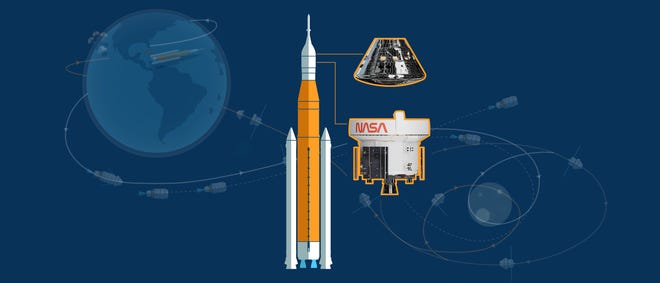NASA officials, already working through technical issues ahead of the Artemis I moon mission, have opted to call off next week’s scheduled launch attempt as Tropical Storm Ian approaches Florida.
Citing the storm and its projected track showing landfall on the state’s west coast, officials on Saturday said the next window to fly – Sept. 27, at 11:37 a.m. – would not be possible due to weather. Ian was expected to strengthen into a hurricane late Sunday.
“During a meeting Saturday morning, teams decided to stand down on preparing for the Tuesday launch date to allow them to configure systems for rolling back the Space Launch System rocket and Orion spacecraft to the Vehicle Assembly Building,” NASA said in a Saturday statement. “Engineers deferred a final decision about the roll to Sunday to allow for additional data gathering and analysis.”
If officials decide a rollback is necessary, that roughly 11-hour process would begin Sunday night or Monday morning.
Ian, meanwhile, continues to churn and gather strength just south of Cuba, according to the latest update from the National Hurricane Center. Current projections show it strengthening to Category 3 status just before making landfall just north of Tampa.
‘Space is the place’:NASA administrator touts Artemis I as the key to our future on Mars
Tropical Storm Ian:Ian forms in Caribbean, could hit Florida as a major hurricane: What we know
But the last few updates from the NHC have shown some promise for NASA officials as the projected path continues moving slightly west. If that trend holds and projections show wind speeds at Kennedy Space Center will be less than 74 knots (about 85 mph), then NASA might opt to keep the rocket on the pad until the next window opens.
As it stands, the current window to fly closes Oct. 4. With the Sept. 27 attempt called off, another try on the backup date of Oct. 2 is possible but depends on several factors. If SLS rolls back to the VAB, that window will likely not be possible.
The Space Force, meanwhile, on Friday moved to “HURCON V” status and began preparing its two Space Coast bases – Cape Canaveral Space Force Station and Patrick Space Force Base – for Ian’s impacts. Because it’s responsible for public safety, military branch has the final say on what launches from both KSC and the Cape and when.
Artemis I is NASA’s first mission under its new return-to-the-moon program. If SLS successfully launches its uncrewed Orion capsule to the moon and back, that will pave the way for astronauts to do the same for Artemis II no earlier than 2024. Artemis III will follow and put two people on the lunar surface sometime before 2030.
For the latest, visit floridatoday.com/launchschedule.
Contact Emre Kelly at aekelly@floridatoday.com. Follow him on Twitter, Facebook and Instagram at @EmreKelly.


